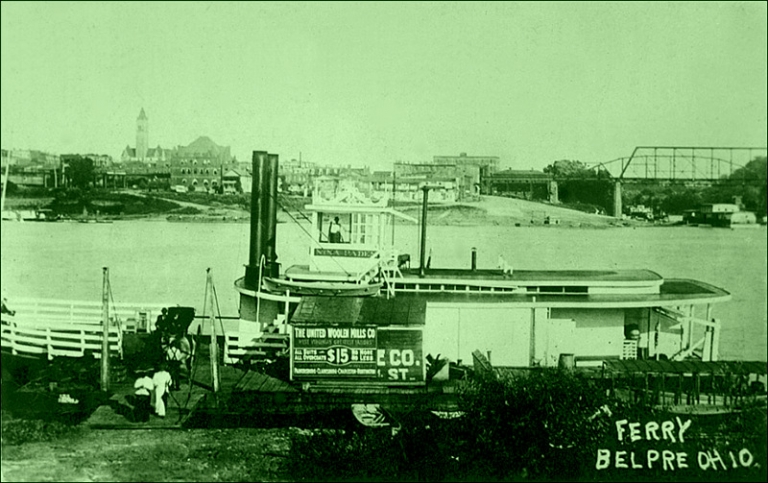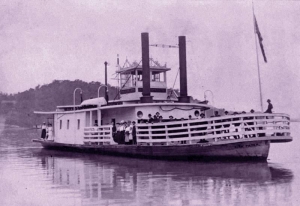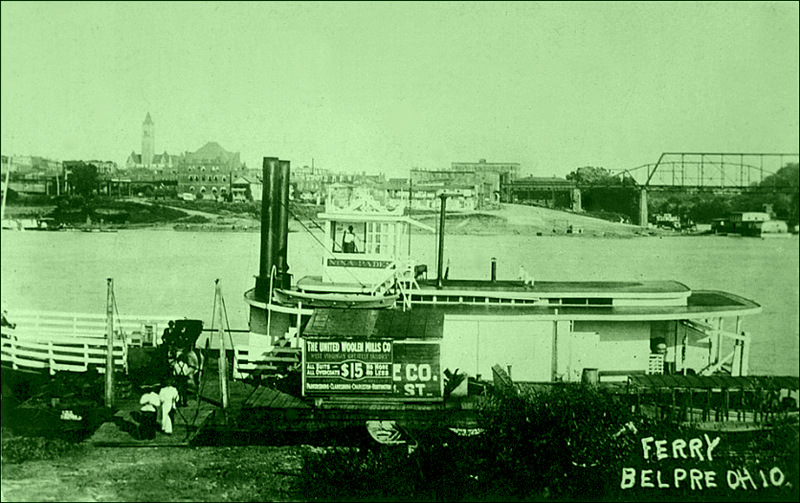
PARKERSBURG, W.Va. — The Nina Paden and its captain went above and beyond his duty in crossing the Ohio River at Parkersburg, West Virginia. Of all the stories about the Ohio, hers may be one of the most fearless.
The following account is by the late Jim Wallen, a reporter for the Huntington Herald-Dispatch, based on his interview with Mrs. Charles F. Crawford, whose father, Noah W. Bucker, captained the ferry for a generation and made it “an instrument of grace in flood and fire.”
Mrs. Crawford was a little girl when she learned the Nina Paden under the leadership of her father, who guided it through some dangerous and exciting events. The Nina Paden In 1907, Captain Buckner was carrying passengers and vehicles across the Ohio between Parkersburg and Belpre, Ohio, when he christened his little daughter “Nina.” And over the years, the captain often let her ride along and showed her how to operate the big steering wheel.

These were unforgettable years for a child who not only loved the boat, but also enjoyed the lively scenes on the river and at the busy waterfront piers. When the large lumber yard in Parkersburg next to the boatyard on the Little Kanawha River caught fire, it was time for the little Nina Paden to carry out the task of towing out some of the large steamships that were moored in the dockyard without steam. Some of these packets and tugs were of imposing size, but the Nina managed to get every single one of them to a safe place, away from the flames.
A few years later, many lives and property were saved by this powerful 103-foot steamboat when it was called into emergency service during the flood of 1913. As the waters continued to advance inland, sweeping away buildings, livestock and even people, Paden sailed from place to place in his territory, rescuing families and bringing on board as much livestock and property as could be taken. For safety’s sake the steamer was brought ashore after dark in a great eddy and tied to the bank, which was slowly whirling around in the bend below Belpre.
Many lived aboard the little steamer when the river was at its highest, and during the frightening nights they could do little but look out over the great expanse of dark, rushing water and wonder at the houses and barns that were quickly being swept away by the current. Often these buildings could be heard breaking and falling apart as they were pushed to the bank by the force of the current that formed the whirlpool.
One night, some members of the crew thought they heard the faint cry of a baby in the black water as a small frame house floated by. There was no question as to what to do, and sure enough, a small child was found in a cradle wedged against a sloping wall on the upper floor, next to the furniture on the second floor. The child was cared for on board the boat and eventually released to his relatives.
The Buckners’ property was near the river at Belpre, and when there was no longer any doubt that it would be severely flooded, Nina Paden came to remove any furniture and valuables that could be salvaged. These belongings were stowed on board, and the Nina was just about to back up when the Buckners’ house collapsed into the brown water.
For several years the popular steamer continued its routine but always interesting task of carrying traffic of cyclists and pedestrians across the Ohio. Mrs. Crawford remembers watching traveling buffalo shows, including an Indian tribe, on the boat’s broad foredeck. Cattle dealers sometimes swam their huge herds across the river to West Virginia, riding their floating steeds, bellowing and cracking whips to keep the cattle together. They were also guided by the steamboat, which carried on its deck some of the herd’s leaders, whom the animals faithfully followed in the water.
In addition to her reliable service and admirable rescue work, the Nina Paden was an important part of every annual event and secured a particularly big place in the hearts of the people in the Parkersburg and Belpre area.
“One of my most vivid memories,” says Mrs. Crawford, “is the annual service held on board our boat every Memorial Day.” At 2 p.m. that day the Civil War veterans, all in their blue and gray uniforms, marched to the boat, followed by citizens with armloads of flowers and wreaths in every imaginable arrangement. After the steamer reached mid-river it stopped, then there was complete silence, followed by a prayer, and the floral offerings were reverently released into the river while we all sang “Nearer, My God, to Thee.”
“After this stirring scene, the old soldiers fired a volley in memory of the Union and Confederate soldiers who had fallen on land and sea. The smoke from their rifles lingered in the air, and the flowers drifted slowly southward on the beautiful river, becoming part of a memory that those who attended the ceremony are sure to have never forgotten. And there are many in and around Parkersburg who will tell you that they counted these old soldiers every year until, at the last of these ceremonies on board ship, they dwindled to only nine men. Nina Paden.”
The captain’s daughter was only nine years old when the Nina Paden left the Belpre wharf for the last time and headed downriver to Ashland, Kentucky, where the trusty steamer had been purchased by the Ashland & Ironton Transfer and Ferry Co. As he turned, the pilot blew a long farewell blast on the steam whistle and got an answer from a packet lying on the bank. Another steamboat picked her up, and then some factory whistles from the town joined in, and even locomotives joined in the chorus.
With a long, appreciative salute, Nina Paden disappeared around the bend.
Captain Buckner and his family moved to Ironton, Ohio, where he took command of the ferry that ran from there to Russell, Kentucky. Later the Buckners went to Proctorville, Ohio, when the captain boarded the fast Huntington-Bradrick ferry Paul F. Thomas. Mrs. Crawford’s brother still lives in Proctorville.
After leaving Belpre and going to Ashland, it was City of Ashlandthe former Nina Paden continued its faithful service back and forth across the river, carrying tens of thousands of passengers between Ashland and Coal Grove, Ohio.
Advertising

